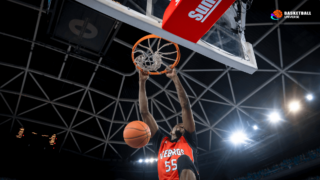
What Does DTD Mean in Basketball?
Written by: Basketball Universe
Last updated:

Welcome, hoop enthusiasts! Are you ready to delve into the world of basketball lingo and expand your understanding of the game? If so, you’ve come to the right place. In today’s blog post, we’ll be exploring a term that just might have you scratching your head: DTD. Understanding various basketball terms and abbreviations can be the difference between merely watching a game and truly appreciating its intricacies. So, lace up your sneakers, grab a ball, and let’s unravel the mystery around the abbreviation DTD and what it means in the captivating and competitive universe of basketball!
What Does DTD Mean in Basketball?
In basketball, the abbreviation DTD stands for “Day-to-Day.” This term is commonly used to describe a player’s injury status, indicating that the athlete’s availability for upcoming games is uncertain due to a minor injury or niggle. When a player is listed as DTD, it implies the injury is not severe but may require ongoing assessment, ultimately making his or her participation in the next games subject to change.
Decoding DTD: When Injuries Take Center Stage
The fast-paced and highly physical nature of basketball makes it an exciting sport to watch and play. However, it also means that injuries are a common occurrence during the season. As such, the term ‘Day-to-Day’ or ‘DTD’ becomes vital when discussing the condition of injured players. Not only does it have a bearing on team strategy, but it also highlights the importance of monitoring and managing player health. In this in-depth exploration of DTD in basketball, we’ll guide you through its significance, its impact on player performance, and what it could mean for both casual fans and fantasy basketball enthusiasts!
Understanding the Intricacies of Injury Management
As with any high-stakes sport, there’s always the risk of injury that can sideline a basketball player. Recognizing the importance of keeping track of player health, teams have designated medical personnel to tend to players’ well-being. These professionals hold the key to understanding DTD and how it applies to an injured player’s situation. Follow us as we examine the different facets of injury management that sometimes land a player’s status as DTD.
The Injury Assessment Process
When a basketball player sustains an injury, the medical team springs into action, evaluating their immediate condition and determining the extent of any potential damage. The results of the initial assessment play a pivotal role in classifying the injury as DTD or otherwise. If the medical staff suspects a minor injury, they may label it as DTD, potentially subjecting the player’s availability for future games to further evaluation.
Categorizing Injuries in Basketball
Basketball injuries can generally be divided into three categories: acute, chronic, or overuse injuries. Acute injuries are typically the result of a specific event, such as collisions, falls, or improper landings. On the other hand, chronic injuries, which include stress fractures and tendonitis, stem from repeated application of force or stress to particular body part. Lastly, overuse injuries occur when a body part is subjected to excessive stress over time without proper rest, leading to wear and tear. Players with minor injuries from any of these categories may be tagged as DTD, underscoring the need for ongoing evaluation and care.
How DTD Affects the Game of Basketball
Now that we’ve established what DTD means in basketball, it’s essential to explore its effects on the game, including team dynamics, coaching decisions, and strategies. Let’s dive into how the DTD status of a player can impact various aspects of basketball.
Coaching Decisions and Lineups
When a player is listed as DTD, coaches may need to make last-minute adjustments to their game plan, taking into account the player’s availability and performance capabilities. This can involve tweaking the starting lineup, managing the injured player’s minutes or even devising alternative strategies to counter the opponent’s strengths. A player’s DTD status can create uncertainty and force coaches to be flexible with their tactics.
Team Dynamics and Morale
A player’s DTD status might affect the overall morale and dynamics among teammates. Star players are often crucial components of a team’s success, and their day-to-day status can make other players feel the pressure to step up and carry the load. In some cases, a heightened sense of responsibility could ignite a spark in other team members, inspiring them to perform better. However, it’s essential to strike a balance to prevent additional injuries or burnout.
Opponent Strategies
Similarly, opposing teams keep an eye on the DTD status of key players, adjusting their strategies accordingly. If a player’s presence on the court is uncertain or their effectiveness hampered by injury, rival squads might exploit this weakness by focusing their defense on a less threatening player or attacking the basket more aggressively.
Beyond the real-world game, the DTD status also holds immense importance in the realm of fantasy basketball. As a participant in a fantasy league, understanding the implications of DTD can give you an edge in building a winning roster. Let’s take a look at the fantasy world and how it deals with DTD!
Build the Right Team
When drafting your fantasy basketball team, being aware of a player’s injury history and susceptibility to DTD status can influence your choices. You’ll need to balance your roster with injury-prone stars and reliable, healthy role players to minimize risk while maximizing potential rewards.
Stay Informed
Keeping abreast of injury updates and monitoring the DTD status of players is crucial in managing your fantasy basketball team. Websites, apps, and social media can provide real-time information to help you make informed decisions about starting, benching, or trading players affected by the DTD injury status.
Master the Waiver Wire
Often, you’ll find hidden gems in the waiver wire who can step up in the absence of an injured player. As a savvy fantasy basketball owner, you must be prepared to make those last-minute additions or drops, depending on the DTD status of your players, to improve your chances of clinching that coveted fantasy title.
How Players Bounce Back: Recovering from DTD Injuries
In this final section, we’ll explore various approaches that players and teams take to recover from DTD injuries and what it means for their performance on the court.
Rehabilitation and Training Adjustments
When injured players are tagged as DTD, they may require adjustments to their training regimen, focusing on rehabilitating the injured area and minimizing the risk of further aggravation. The medical staff, in collaboration with the strength and conditioning team, designs tailored recovery programs that can be integrated into their routine, ensuring they’re back in action as soon as possible.
Balancing Rest and Performance
Managing recovery time is crucial for players on DTD status, as they need to find a balance between rest and maintaining their competitive edge. Too much rest may cause their skills to become rusty, while insufficient rest could lead to re-injury or exacerbation. Players work closely with their coaches and medical professionals to strategize the appropriate balance for optimal recovery and performance.
With this comprehensive, in-depth exploration of DTD in basketball, you now have a much better understanding of how day-to-day injury statuses can impact players, teams, and even fantasy basketball leagues. As you watch games or manage your fantasy roster, you’ll have deeper insight into the basketball world and a newfound appreciation for the importance of managing player health and well-being.
Strategies for Preventing DTD Injuries in Basketball
Now that we’ve explored DTD and its implications within the world of basketball, it’s essential to examine the strategies that players and teams can employ to minimize the chances of sustaining these injuries. By taking the right preventive measures, basketball professionals at all levels can reduce the risk of finding themselves in a DTD situation, enabling them to focus on their performance and contribute to their team’s success.
Proper Conditioning and Training
Prioritizing a comprehensive and balanced training program can be instrumental in minimizing the risk of DTD injuries. A well-designed regimen should include exercises that develop strength, flexibility, and endurance, as well as sport-specific skills. Working with experienced coaches, trainers, and medical professionals can help devise training programs tailored to a player’s individual needs, addressing physical weaknesses and improving overall resilience.
Utilizing Proper Techniques
Another critical aspect of injury prevention is the utilization of proper techniques during play, which can be essential for skills such as shooting, passing, and rebounding. Ensuring that players are executing these techniques correctly can not only enhance their overall performance but also minimize the stress on specific body parts, helping to prevent injuries from occurring in the first place.
Recovery and Rest
Recovery is a crucial element of injury prevention in basketball. Players must pay close attention to their rest and recovery routines, as overtraining and inadequate rest can leave them more susceptible to injuries. Incorporating tactics such as foam rolling, massages, hydrotherapy, and sleep optimization can help players recover more effectively and reduce the chances of being tagged as DTD.
Wearing Appropriate Protective Gear
Lastly, wearing the right protective gear can make all the difference in reducing injury risk. Players should ensure they have high-quality footwear with proper cushioning and ankle support, as well as utilizing other protective equipment, such as knee pads, mouthguards, and compression apparel. These products can help safeguard against some of the most common injuries sustained in basketball.
Sports Psychology and the Road to Recovery
While physical factors are crucial when dealing with DTD injuries, it’s crucial not to underestimate the psychological aspects associated with injury management and recovery. The mental resilience of a player can significantly influence how they cope with injuries, and being prepared to handle the psychological challenges that arise from being injured can be vital to a successful return to the game.
Mental Preparation for Injury Recovery
When a player sustains an injury or is listed as DTD, mental preparation can play a pivotal role in how they approach the healing process. Working with sports psychologists, players can learn techniques for managing stress, staying focused on their rehabilitation, and maintaining a positive attitude, even when confronted with setbacks during recovery.
Visualizing Success
Visualization is an essential tool employed by sports psychologists to help injured athletes regain their competitive edge. By mentally rehearsing specific skills, movements, and game situations during the recovery period, players can maintain their mental sharpness and remain connected to the game, even when they’re physically unable to participate.
Building Resilience through Adversity
Overcoming a DTD injury can be an opportunity for personal growth and increased resilience in basketball players. By embracing the challenges that accompany recovery, players can develop mental fortitude, making them more capable of handling future obstacles and setbacks in both their careers and their lives beyond the court.
In conclusion, understanding DTD in basketball involves more than just knowing the abbreviation’s meaning. By examining its implications, the strategies for prevention, and the importance of mental resilience during recovery, you are now better equipped to approach the game with a greater appreciation and insight into the world of basketball and player management.
Frequently Asked Questions (FAQ) about DTD in Basketball
If you still have queries or are curious about specific aspects of DTD in basketball, this FAQ section aims to address some of the most common questions. Get answers to your doubts as we answer thirteen frequently asked questions related to DTD!
1. Who decides if a player is listed as DTD?
Usually, a team’s medical staff and coaches collaborate to determine if a player is listed as DTD, taking into consideration the player’s health, injury severity, and ongoing risk assessments.
2. How long can a player be in DTD status?
A player can be in DTD status for a short or extended period, depending on their injury’s nature, severity, and recovery progress. There is no fixed timeframe as it often depends on various factors such as healing and rehabilitation.
3. Can a player’s status change from DTD to a more severe injury designation?
Yes, a player’s status can change from DTD to a more severe injury designation if further evaluations reveal that the injury is worse than initially anticipated or if the player’s recovery does not progress as expected.
4. Can a player participate in team practices and training sessions while listed as DTD?
It depends on the player’s condition and advice from the medical staff. In some cases, players may participate in team practices and training sessions with specific limitations or restrictions to protect the injured area while they recover.
5. What other injury designations or statuses exist in basketball besides DTD?
Other common injury designations or statuses in basketball include Out (O), which means a player will definitely not play in an upcoming game, and Probable (P), where there is a high likelihood that the player will participate.
6. Is DTD specific to basketball, or is it used in other sports as well?
The DTD designation is used across various sports, including but not limited to basketball. It is a common term in sports injury management, allowing teams and coaches to assess the health of their athletes and make informed decisions.
7. Can a player have multiple DTD injuries?
Yes, a player can have multiple DTD injuries simultaneously, requiring the medical staff to monitor each injury and provide appropriate care and management as per the individual’s condition and recovery progress.
8. Do coaches need to report DTD injuries to the league?
Yes, coaches and teams are usually required to report injuries, including DTD statuses, to the league. This information is crucial to maintaining transparency, keeping fans and media informed, and helping opposing teams plan their strategies.
9. What can fans do to stay informed about a player’s DTD status?
Fans can follow news updates, use sports apps, and monitor social media accounts of their favorite teams and players to stay informed about DTD statuses and other injury-related news.
10. How does DTD status impact player salaries and contracts?
The DTD status itself typically does not impact a player’s salary or contract. However, frequent injury concerns, including multiple occurrences of DTD, may influence future negotiations when it comes to a player’s market value and contract terms.
11. What is load management in basketball, and how does it relate to DTD?
Load management refers to the practice of monitoring and controlling a player’s activity levels and minutes on the court to reduce the risk of injury and fatigue. It can be an essential tool in preventing players from being designated as DTD and maintaining optimal player health throughout the season.
12. What role do advanced analytics play in managing DTD injuries?
Advanced analytics can be used to identify trends, risk factors, and recovery patterns related to DTD injuries. This information can be invaluable in helping teams and medical staff refine their injury management strategies, optimize player performance, and mitigate the risks associated with DTD injuries.
13. Are there any resources or tools that can help me understand and track DTD and other injuries in basketball?
Several websites, apps, and platforms provide detailed information and updates on player injuries, including DTD statuses. Some popular resources include Rotoworld, ESPN Injury Report, and the official website of the league you follow (e.g., NBA).
Featured Posts
- No pillar pages found.




